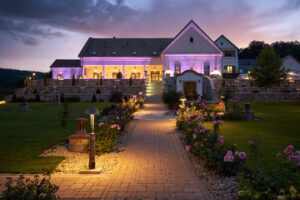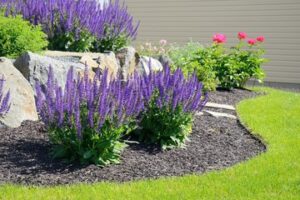A well-designed and maintained landscape lighting system can make your home stand out in the neighborhood. But sometimes things break or need a little TLC.

Flickering or a gradual loss of brightness can signal a lamp that is burning out. These replacement kits contain everything you need to keep your lights running bright. Connect with Elegant Custom Images Inc for reliable help.
Lighting fixtures, like all other components of a landscape lighting system, need to be properly maintained for the best possible performance. Performing some simple maintenance tasks, such as replacing light bulbs or repositioning fixtures, can help to extend the life of your outdoor lighting system.
If you notice that one or more of your landscape lights are not turning on, first check to make sure the bulb isn’t burned out or faulty. If the bulb isn’t the problem, then check for loose connections or a blown fuse. Loose connections can interrupt the flow of electricity between the transformer, wires, and fixture, resulting in dim or flickering lighting. Re-tighten loose connections and replace any broken parts to restore full illumination.
Landscape lighting fixtures are exposed to rain, sun, and other weather elements on a daily basis. High quality professional grade fixtures made of brass or copper are designed to withstand these conditions and can develop an attractive patina over time that provides a unique aesthetic that complements many different landscape designs. Low quality aluminum or steel fixtures, on the other hand, are more susceptible to rust and corrosion. If you have a lot of rust or corrosion on your landscape lighting fixtures, they may need to be replaced.
Over time, your outdoor lighting fixtures can shift from their original installation locations due to wind and other factors. This can lead to them being blocked by overgrown plants and can even result in them not adequately lighting the area they are intended to illuminate. Fortunately, this is an easy problem to fix by simply repositioning the fixtures.
Flickering lights indicate that the bulbs aren’t delivering the proper amount of illumination to the surrounding area. If this is the case, it’s important to replace the bulbs promptly with a higher-wattage option that matches the specifications of the existing fixture. Also, be sure to clean the lenses and covers of your lighting fixtures regularly. This can keep dirt and debris from accumulating, which could impact the quality of the illumination. Performing these simple maintenance tasks can significantly extend the lifespan of your landscape lighting system.
Wiring
A well-designed landscape lighting system can add a stunning visual impact to your home, even after dark. But it’s not without its share of challenges. If your lights aren’t performing the way they should, it might be time to call in the professionals.
Wiring problems in a landscape lighting system can be difficult to troubleshoot. They often happen as a result of wear and tear or bad installation. This can include a wide variety of issues that don’t always show up as obvious visible damage, such as a consistent flickering of lights or frequent tripping of circuit breakers.
Some of these problems may require digging wires to examine, while others may be difficult to locate because they happen at the transformer or in the buried wiring. Using a voltmeter to check voltage can be very helpful in these cases, and the results can help determine whether or not a replacement transformer is needed.
If one or more of your lights are not working, you can usually try replacing the light bulb to see if this fixes the issue. However, if the light is still not coming on, it might be that the socket is bad. A quick test can be performed by plugging in a different light bulb to see if the fixture responds with illumination.
Lastly, the wiring and connections in a landscape lighting system can also decay over time due to weather exposure. This is especially true when a system is installed with older products such as wire nuts and pierce connectors that are not designed to be used underground. These connections will loosen and corrode over time, resulting in electrical shorts.
A professional can examine your landscape lighting system and make recommendations based on the specifics of your Memphis property and what you would like your property to look like at night. They can repair, replace or do both for you. Ultimately, it is up to you and your budget which option makes the most sense for you.
Sockets
A lighting system’s sockets are the connections between the fixture and the wire. They must be well insulated to protect the wire from moisture, which can cause damage and make a fixture inoperable. In addition, the sockets must be high quality to avoid corrosion or rust. When a fixture isn’t working, it may be a sign that the bulbs are burned out or that the sockets need to be replaced.
When a landscape lighting system experiences a problem, it’s important to perform a thorough repair and maintenance project to address the issue. This includes cleaning the lights and fixtures, checking wiring, and ensuring that all components are functioning properly. Performing these tasks can help prevent future problems and ensure that the system is running at peak performance.
Before starting your landscape lighting repair project, be sure to turn off power to the transformer and use insulated tools to ensure safety. Then, assess the scope of your project and develop a detailed plan. This will include identifying all issues and addressing them in an organized way. It’s also important to prioritize safety by turning off the power to the circuit before beginning work, using a voltage tester, and wearing protective gear such as gloves and safety glasses.
During your landscape lighting maintenance project, you should also clean the lenses on the fixtures to remove any mineral deposits that can make them appear dimmer. This is an important part of any outdoor lighting maintenance plan, as it will keep your lights looking their best and help them last longer.
Another essential component of a landscape lighting repair project is ensuring that the socket connections are water tight. This will help reduce the amount of time that your system spends under warranty due to moisture damage. One way to achieve this is to switch from a screw-type connection to a copper crimp or heat shrink connection, which are less likely to come loose and cause a leak.
If you’re having issues with your landscape lighting, it’s important to contact a professional residential contractor that specializes in low-voltage lighting installation and repairs. They will be able to identify and address any issues that you have with your landscape lighting system.
Transformers
The transformer is the power center of your landscape lighting system. It steps down electrical voltage to the low voltage required by your landscape lighting fixtures. It also helps regulate the amount of energy being delivered to each fixture by controlling the current and brightness.
Having the right transformer for your system will help ensure it runs efficiently and safely. It will also help you design a more effective lighting system by connecting multiple lights on the same circuit.
A well-designed and installed lighting system can add tremendous value to your Memphis home. However, not all homeowners understand what it takes to get the most value out of a landscape lighting system. That’s why they need the help of a professional landscape lighting contractor to keep their system working properly and to avoid costly repairs.
Common landscape lighting repair issues stem from problems with wiring or connections. Since much of this wiring is buried underground and exposed to the elements, it can decay quickly. When this happens, electricity will jump between loose connections. This can melt wires and in extreme cases cause fires.
The best way to prevent these problems is by having a high-quality system and following a regular maintenance plan. This includes trimming plants and trees so they don’t cover up the lighting wires and burying any exposed lines. In addition, homeowners can check the GFCI receptacle on their transformer to make sure it’s functioning properly and cleaning out the weatherproof enclosure regularly to eliminate any ants or other pests from nesting inside the transformer.
Lastly, homeowners can check the transformer’s wire connections to make sure they are tight. They can do this by removing the weatherproof panel and physically inspecting them. If the wires are melted or have a corroded appearance, they should be replaced.
For a high-quality and durable landscape lighting system, Reinders is the one-stop shop for all your fixture needs. Our wide selection of cast bronze, low-voltage light fixtures features the perfect combination of art and engineering. We offer several beam spreads and styles to fit your outdoor lighting design, and we’re proud to carry the same top brands of transformers and parts that you trusted when you designed your landscape lights.
